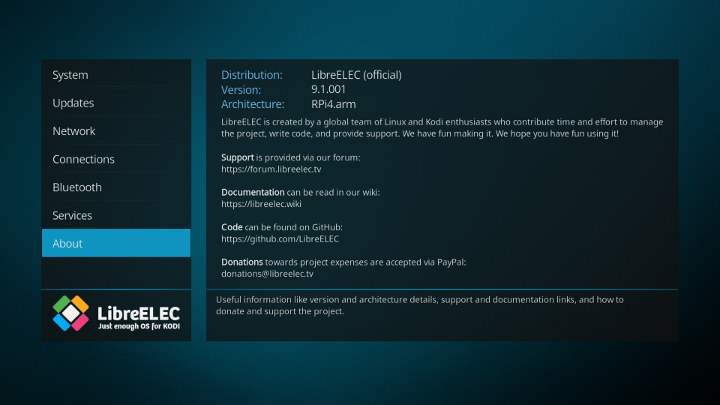In my short Raspberry Pi 4 review, I tested 4K video output and playback in Raspbian, and sadly neither are working properly, with video output stuck to 1080p60 even after selecting 4K HDMI in the settings and yes, I double checked for “hdmi_enable_4k=1” in config.txt, while H.265 video playback is still clearly using software decode in both VLC and omxplayer.
However, LibreELEC team announced support for Raspberry Pi 4 in LibreELEC 9.2 Alpha1 release based on Kodi 18.3 and Linux 4.19.x. So I downloaded LibreELEC-RPi4.arm-9.1.001.img.gz and flash it to a microSD card with balenaEtcher.
The good news is that I could manually set the resolution to 3840×2160 and confirm it works with my TV, but the refresh is limited to 30 Hz maximum. Other refresh rates currently available include 23.98 Hz, 24 Hz, 25 Hz, and 29.97 Hz. The hardware is capable if 4K 60Hz, so it’s just a question of time before this is fixed. Note LibreELEC for RPi4 is currently at the alpha stage of development.

Now I went on to play some H.265 4K videos stored in a hard drive connected to the USB 3.0 port of the single board computer:
- Beauty_3840x2160_120fps_420_8bit_HEVC_MP4.mp4 (H.265) – OK
- MHD_2013_2160p_ShowReel_R_9000f_24fps_RMN_QP23_10b.mkv (10-bit HEVC) – OK, but some frame dropped as I set refresh rate to 30 Hz (and automatic frame rate switching is not yet supported)
- BT.2020.20140602.ts (10-bit H.265, Rec.2020 compliant video; 36 Mbps; 59.97 Hz) – OK
- ifa_WorldCup2014_Uruguay-Colombia_4K-x265.mp4 (4K, H.265, 60 fps) – OK, but could be a bit smoother
It’s a bit hit and miss, but it should improve over time. All were shown to be decoded by hardware with “ff-hevc-mmal (HW)” video decoder.
I went on to play some 4K H.264 and VP9 videos which are NOT supposed to be supported by the hardware:
- HD.Club-4K-Chimei-inn-60mbps.mp4 (H.264, 30 fps) – Not smooth at all
- big_buck_bunny_4k_H264_30fps.mp4 – Extremely choppy, A/V sync issues
- tara-no9-vp9.webm (4K VP9 YouTube video @ 60 fps, Vorbis audio) – Not smooth at all
I was expecting this result, but even worse. What’s strange is that Kodi overlay window implies some sort of hardware decoder is used for both:
- H.264 – ff-h264-mmal (HW) with only one CPU core used for decoding
- VP9 – ff-vp9-mmal (HW) with only one CPU core used for decoding
H.264 is not so surprising since VideoCore VI GPU support H.264 up to 1080p60, but there’s no word about VP9 at all.
Raspberry Pi 4 is supposed to support HDR, but “software support has a dependency on the new Linux kernel frameworks merged by Intel developers (with help from Team LibreELEC/Kodi) in Linux 5.2 and a kernel bump will be needed to use them”.
Watch the video below where I try 4K videos in Raspberry Pi 4 SBC.

Jean-Luc started CNX Software in 2010 as a part-time endeavor, before quitting his job as a software engineering manager, and starting to write daily news, and reviews full time later in 2011.
Support CNX Software! Donate via cryptocurrencies, become a Patron on Patreon, or purchase goods on Amazon or Aliexpress




